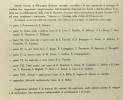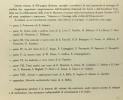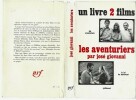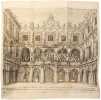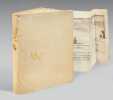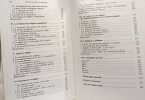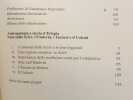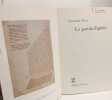2857 books for « giovanni »Edit
-
Type
Book (2784)
Engraving (3)
Magazine (3)
Maps (51)
Music sheets (13)
New book (2)
Photographs (1)
-
Latest
Last 3 days (5)
Last month (78)
Last week (10)
-
Language
Dutch (1)
English (2)
French (2804)
German (1)
Italian (37)
Latin (4)
Russian (8)
-
Century
16th (82)
17th (67)
18th (123)
19th (196)
20th (1271)
21st (162)
-
Countries
Belgium (233)
Brazil (2)
Canada (16)
Denmark (17)
France (1879)
Germany (8)
Greece (3)
Italy (328)
Netherlands (1)
Switzerland (348)
United Kingdom (14)
United States of America (8)
-
Syndicate
ALAC (16)
CLAM (14)
CLAQ (9)
CNE (2)
ILAB (1342)
NVVA (53)
SLACES (53)
SLAM (940)
SNCAO (1)
Topics
- 1900 (54)
- Africa (6)
- Archaeology (30)
- Architecture (35)
- Astronomy (7)
- Atlas (6)
- Belgium (7)
- Biography (22)
- Boccaccio (134)
- Bofa gus (15)
- Brunelleschi (7)
- Cartomancy (18)
- Casanova knight (9)
- Caselli giovanni (10)
- Catholicism (15)
- Ceramic (6)
- Children’s books (10)
- Christ (the) (8)
- Christianity (12)
- Cinema (11)
- Civilisation (11)
- Comic strip (10)
- Detective novels (29)
- Dotoli giovanni (6)
- Drawings (7)
- Early printed books (20)
- Economics (10)
- Engraving (books about) (9)
- Entomology (12)
- Erotic (9)
- Ethic (11)
- Europe (31)
- Fine arts (55)
- First edition (41)
- Flora (8)
- Franco (9)
- Futurism (21)
- Geography (22)
- Germanic languages (13)
- Greece (25)
- Guareschi giovanni (68)
- Guide books (12)
- Helvética (21)
- History (135)
- Illustrated books (10)
- Industrial arts & crafts - fine arts (19)
- Italian (203)
- Italian literature (37)
- Italy (206)
- Latin (22)
- Law (21)
- Lista giovanni (10)
- Literature (196)
- Liturgy (7)
- Lorenzo (8)
- Maps (56)
- Medicine (35)
- Middle ages (9)
- Music (16)
- Painting (19)
- Papini giovanni (67)
- Paris (8)
- Perrault charles (6)
- Philology (22)
- Philosophy (60)
- Photography (12)
- Poetry (44)
- Policy (14)
- Psychology (10)
- Ptolemy (13)
- Religions (74)
- Reverend (24)
- Review (18)
- Rome (25)
- Sciences (15)
- Scores (41)
- Sculpture (15)
- Simone (6)
- Sociology (12)
- Songs (12)
- Switzerland (25)
- Symbolism (8)
- Tales (16)
- Tea (7)
- Technology (27)
- Theatre (18)
- Theology (33)
- Translation (11)
- Travel (9)
- Turkey - ottoman empire (8)
- Various (17)
- Vatican city (6)
- Venice (13)
- War (10)
- Western (10)
Au nom de Saint François: Histoire des Frères mineurs et du franciscanisme jusqu'au début du XVIe siècle
Cerf 2006 in8. 2006. Broché.
Bon état
Mantova e i gonzaganella civiltà del rinasciment - atti del convegno organizzato dall'accademia nazionale virgiliana con la collaborazione della città di mantova sotto l'alto patronato del presidente
Mantova 1974 in4. 1974. Broché. Mantova e i gonzaganella civiltà del rinasciment - atti del convegno organizzato dall'accademia nazionale virgiliana con la collaborazione della città di mantova sotto l'alto patronato del presidente della repubblica Italiana Giovanni Leone --- Mantoue et la civilisation gonzaganella de la Renaissance - actes de la conférence organisée par l'académie nationale de Virgilian avec la collaboration de la ville de Mantoue sous le haut patronage du président Giovanni Leone --- livre en italien
Bon Etat de conservation jaquette abîmée sur le dos intérieur propre qq rousseurs
Giovanni le bienheureux
Belfond 2014 288 pages in8. 2014. Broché jaquette. 288 pages.
Très Bon Etat
The decameron of giovanni boccaccio
J.m dent & sons ltd 1950 in12. 1950. Cartonné.
yellow pages. Slightly taken the freshness. pages jaunis légèrement défraîchie
TAVOLA IV Le loggie di Rafaele nel Vaticano" In Roma: nella stamperia di Marco Tagliarini, 1772.
1776
AUTORE: Giovanni Ottaviani su disegno di Gaetano Savorelli e Pietro Camporese DATA: 1774-1776 circa TECNICA: acquaforte DIMENSIONE DELLA PAGINA: 55x43 cm, 57x42 DIMENSIONE DELL'INCISIONE: 52x41 cm, 56x41 CONDIZIONI: buone In alto, a destra, dentro battuta "IV". In basso a sinistra "Cai Savorelli Pict., et Pet. Camporesi Arch. delin.", e a destra "Joann. Ottaviani sculp. Cum privilegio SS. D. N. Clementis XIII" Più sotto "Palmi .tre Romani, Piedi tre di Londra, Piedi tre di Parigi". " Splendida raccolta di incisioni litografiche di notevole dimensione incise da Giovanni Ottaviani su disegno di Gaetano Savorelli e Pietro Camporese. Le due incisioni che si completano vanno a formare la tavola quarta. La serie d'inicisioni, cui Volpato deve gran parte della propria notorietà nell'ambiente incisorio romano del suo tempo, è la prima opera che affronta la riproduzione degli ornati dei pilastri delle Logge, affrescate da Raffaello e allievi negli appartamenti vaticani, in modo dettagliato e completo. Uscirono in tre volumi, tra il 1772 e il 1776, frutto della collaborazione del pittore Gaetano Savorelli, dell'architetto Pietro Camporesi e dell'incisore Giovanni Ottaviani per la prima parte, cui dal 1772 si aggiunsero Ludovico Teseo e Volpato, che firmarono le tavole della terza parte raffigurante i pilastri." da Giovanni Volpato 1735-1803 p. 122. Volpato assunse la direzione dell'opera. In ottime condizioni.AUTHOR: Giovanni Ottaviani after Gaetano Savorelli and Pietro Camporese DATE: 1774-1776 circa TECHNIQUE: etching DIMENSION OF PAGE: 55x43 cm, 57x42 DIMENSION OF ENGRAVING: 52x41 cm, 56x41 CONDITIONS: good In the upper right edge, "IV". In the lower left edge "Cai Savorelli Pict., et Pet. Camporesi Arch. delin.", e a destra "Joann. Ottaviani sculp. Cum privilegio SS. D. N. Clementis XIII" Più sotto "Palmi .tre Romani, Piedi tre di Londra, Piedi tre di Parigi". " Wonderful collection of lythographed engravings of huge size engraved by Giovanni Ottaviani after Gaetano Savorelli and Pietro Camporese. These two engravings complete and form the fourth plate. This series of plates is the first work facing the reproduction of decoration of columns of lodges, painted as frescoes by Raffaello and pupils in Vatican apartments, in a complete and detailed way. The work was published in three volumes, between 1772 and 1776, fruit of cooperation with the painter Gaetano Savorelli, of the architect Pietro Camporesi and the engraver Giovanni Ottaviani for the first part, from 1772 Ludovico Teseo and Volpato, who signed the plates of third part featuring columns." from Giovanni Volpato 1735-1803 p. 122. Volpato got the direction of the work. In very good conditions.
( Littérature adaptée au Cinéma ) - Joseph Antoine Roger Damiani dit José Giovanni.
Reference : 29385
(1998)
Les Aventuriers - La loi du Survivant. ( Avec jaquette photo et magnifique lettre autographe de deux pages, sous enveloppe, de José Giovanni, adressée à Auguste le Breton ).
Editions Gallimard 1960. In-12 broché de 278 pages au format 19 x 12 cm. Couverture illustrée. Dos carré. Plats et intérieur frais. Complet de la rare jaquette avec photographies extraites des films ( Alain Delon, Lino Ventura, Joanna Shimkus, Michel Constantin et Alexandra Stewart ). Superbe état général. Rare édition originale. Précieux exemplaires avec une magnifique lettre autographe de deux pages, sous enveloppe, écrite par José Giovanni et adressée à Auguste le Breton. Provenance idéale. De ce roman furent réalisé 2 films : Les Aventuriers réalisé par Robert Enrico, sorti en 1967 avec scénario et dialogues de Robert Enrico, José Giovanni et Pierre Pelegri. Il s agit de l'adaptation de la première partie du roman homonyme de José Giovanni avec dans les rôles principaux : Lino Ventura, Alain Delon, Joanna Shimkus, Serge Reggiani, Paul Crauchet, Odile Poisson. La seconde partie du roman, a été adaptée au cinéma la même année sous le titre " La Loi du survivant " par José Giovanni lui-même. Il s'agit de la première réalisation de José Giovanni sur son scénario et ses dialogues. On trouve dans les rôles prtincipaux : Michel Constantin, Alexandra Stewart, Edwine Moatti, Roger Blin.
Vente exclusivement par correspondance. Le libraire ne reçoit, exceptionnellement que sur rendez-vous. Il est préférable de téléphoner avant tout déplacement.Forfait de port pour un livre 8,50 €, sauf si épaisseur supérieure à 3 cm ou valeur supérieure ou égale à 100 €, dans ce cas expédition obligatoire au tarif Colissimo en vigueur. A partir de 2 livres envoi en colissimo obligatoire. Port à la charge de l'acheteur pour le reste du monde.Les Chèques ne sont plus acceptés.Pour destinations extra-planétaire s'adresser à la NASA.Membre du Syndicat Lusitanien Amateurs Morues
[Giovanni David] - Newcome Schleier, Mary and Giovanni Grasso
Reference : 079827
(2003)
ISBN : 8880520199
Giovanni David. Pittore e Incisore della Famiglia Durazzo
Newcome Schleier, Mary and Giovanni Grasso: Giovanni David. Pittore e Incisore della Famiglia Durazzo. Turin: Artema, 2003. 213pp with 52 colour and 134 monochrome illustrations. Hardback. 24.6x25cms. Giovanni David 1743-1784 is now best known for his etchings pioneering the technique of aquatint, but was also a versatile painter and draughtsman who, with his predilection for dramatic subjects and fascination with death, was a precursor of Romanticism. Includes two recently discovered albums of drawings of views of English and French gardens, palaces and townscapes he made, during a tour across Europe accompanying members of the Durazzo family. Text in Italian.
Giovanni David 1743-1784 is now best known for his etchings pioneering the technique of aquatint, but was also a versatile painter and draughtsman who, with his predilection for dramatic subjects and fascination with death, was a precursor of Romanticism. Includes two recently discovered albums of drawings of views of English and French gardens, palaces and townscapes he made, during a tour across Europe accompanying members of the Durazzo family. Text in Italian
PHYSIOGNOMONIAE COELESTIS
ARGENTORATI IMPENSIS LAZARI ZETZNERI BIBLIOPOLAE 1606
Seconda o terza edizione del 1606 di questa rara opera del filosofo alchimista commediografo e scienziato Giovanni Battista Della Porta (1535-1615) che collega astrologia, fisiognomia e predizione del futuro. La data di pubblicazione della prima è incerta, a lungo è stata fissata nel 1601 ma molto probabilmente è del 1603. Nellopera Della Porta tenta di riconciliare larte della profezia basata su una misteriosa connessione tra la terra e gli astri e la dottrina ortodossa del libero arbitrio e condanna del giudizio astrologico. Luomo è mosso non dalle influenze astrali ma dagli elementi che compongono il suo corpo e che inoltre determinano i diversi caratteri dei pianeti e stelle. Tutti parte di un più vasto sistema. Leggendo i segni naturali un esperto può predire il futuro al quale le tendenze indicate lo condurranno. Giambattista della Porta (1535?-1615) conosciuto anche come Giovanni Battista della Porta fu uno scienziato e commediografo italiano che visse a Napoli al tempo della Rivoluzione scientifica e riforma. Giambattista della Porta passò la gran parte del suo tempo occupandosi di scienza. Beneficiò di un educazione informale di tutori e visite di rinomati studiosi. La sua opera più famosa, pubblicata nel 1558 si intitola Magiae Naturalis. Nellopera tratta di varie materie come filosofia occulta, astrologia, alchimia, matematica, meteorologia e filosofia naturale. Era noto anche come Professore di segreti. Osler 3723 "Rara e importante opera di speculazione astrale". Riccardi, II, 311. Krivatsy, 9170. Bibl. Magica Casanatense, n. 353. Houzeau-Lancaster, 5013. Cat. British Library, p. 700. In buone condizioni. Copertina in pergamena moderna con titolo manoscritto al dorso in ottime condizioni. Legatura in ottime condizioni. Pagine in buone condizioni con rare fioriture. Il frontespizio è stato rinforzato con lapplicazione di carta al verso. In 16 cm. 15,5x11. Pp. (16)+213+(3) Contents: [(16)+213+(3)]. In 16 (6.1 x 4.3 in; 155 x 110 mm) Weight Kg. 0,160. Condition of contents: Good conditions. Occasional foxings. Title page has been reinforced in the verso with paper Condition of binding: Full parchment coeval cover with handwritten title in the spine in very good conditions. Binding in good conditions. Pages in good conditions with occasional foxings. Second or third edition of 1606 of this scarce work by the phylosopher alchemist dramatist and scientist Giovanni Battista Della Porta (1535-1615) conenecting astrology, physiognomy and prediction of future. The date of the first edition is uncertain, 1601 but probably of 1603. The theory of Della Porta was that man is directed not by astral influences but by the elements which compose his body and which also determine the various characters of planets and stars. Human beings and heavenly bodies are all part of a vast system of signatures. By reading the natural signs, an expert can foretell the future to which the indicated tendencies will lead. "One of the most impressive illustrations of the effect of the bull of Sixtus V against astrology is offered by Giovanni Baptista Porta, who had written on natural magic, physiognomy and other subjects bordering upon the occult- In 1603 he published at Naples six books of Celestial Physiognomy, in which the future could easily be conjectured from inspection of the human countenance, but which also astrology was refuted and shown to be inane and imaginary." Thorndike: A History of Experimental Science, Vol. VI, p.162 Giambattista della Porta (1535? - 4 February 1615), also known as Giovanni Battista Della Porta, was an Italian scholar, polymath and playwright who lived in Naples at the time of the Scientific Revolution and Reformation. Giambattista della Porta spent the majority of his life on scientific endeavors. He benefited from an informal education of tutors and visits from renowned scholars. His most famous work, first published in 1558, is entitled Magiae Naturalis (Natural Magic). In this book he covered a variety of the subjects he had investigated, including occult philosophy, astrology, alchemy, mathematics, meteorology, and natural philosophy. He was also referred to as "professor of secrets". Osler 3723. "Rara e importante opera di speculazione astrale". Riccardi, II, 311. Krivatsy, 9170. Bibl. Magica Casanatense, n. 353. Houzeau-Lancaster, 5013. Cat. British Library, p. 700.
TRENTA NOVELLE DI MESSER GIOVANNI BOCCACCIO SCELTE DAL SUO DECAMERONE AD USO DEI GIOVANI STUDIOSI LA TOSCANA FAVELLA <BR><BR>
FIRENZE TIPOGRAFIA FRATICELLI 1859
Edizione del 1859 della celebre opera "Il Decameron" di Giovanni Boccaccio (1350-1353). Scritta verso la metà del XIV secolo vide la luce probabilmente nel 1470. A causa di numerosi riferimenti all'erotismo fu tacciata di immoralità o scandalo e in molte epoche censurata. All'inizio vita e opere di Giovanni Boccaccio compilate da G. Bencivenni Pelli alla quale segue "Descrizione della pestilenza stata in Firenze l'anno 1348". In buone condizioni. Copertina in mezza pelle in buone condizioni generali con lievi usure ai margini e dorso. Legatura in buone condizioni. Pagine in ottime condizioni con rare fioriture. In 24. Dim. 14x8,5 cm. Pp. 304Edition of 1859 of the famous work "Il Decameron" by Giovanni Boccaccio (1350-1353). The work was probably written in the half of XIV century and was probably published in 1470. Due to different refeerings to erotism it was accused of erotism and immorality or scandal and censored in different periods. At the beginning life and works by Giovanni Boccaccio written by G. Bencivenni Pelli then "Descrizione della pestilenza stata in Firenze l'anno 1348". In good conditions. Half leather cover in good conditions lightly worn in the extremities. Binding in good condition. Pages in very good conditions with occasional foxing. In 24. Dim. 14x8,5 cm. Pp. 304
Descrizione delle Pitture, Sculture, ed Architeture, Che si osservano nella Città di Mantova, e ne' suoi Contorni, data in luce, a comodo singolarmente de' Forestieri , da Giovanni Cadioli, Pittor Mantovano, ed Architetto Teatrale
Cadioli, Giovanni: Descrizione delle Pitture, Sculture, ed Architeture, Che si osservano nella Città di Mantova, e ne' suoi Contorni, data in luce, a comodo singolarmente de' Forestieri , da Giovanni Cadioli, Pittor Mantovano, ed Architetto Teatrale. Mantua: Per l'Erede di Alberto Pazzoni, 1763. 136 pages, with woodblock vignettes. In an elegant contemporary red leather binding with five raised bands, floral gilt panels and gilt borders, gilded paper'damask' dentelles, all edges gilt. 19.5 x 12.5cms. Giovanni Cadioli (1710 -1767) was a Mantuan artist. In 1752 established the Academy of Fine Arts of Mantua, and later became its director. Text in Italian.
Giovanni Cadioli (1710 -1767) was a Mantuan artist. In 1752 established the Academy of Fine Arts of Mantua, and later became its director. Text in Italian
Carlo Magno festa Teatrale à l’occasion de la naissante de Delfino offerta alle… Re, e Regina de Francia dal Cardinale Otthoboni. Les Fêtes organisées par le Cardinal de Polignac à Rome en 1725 et 1729 ornées de 16 planches d’un intérêt remarquable.
Unique volume répertorié présentant 9 éditions originales rarissimes, dont 3 manquant à la B.n.F., relatant les fêtes organisées à Rome en 1725 et 1729 pour célébrer le mariage de Louis XV et la naissance du Dauphin en reliure de l’époque. Volume in-4 relié en vélin ivoire de l’époque, dos lisse. 237 x 175 mm.
Le Cardinal Melchior de Polignac est nommé ambassadeur à Rome, son ambassade lui permet de donner libre cours à sa passion pour les antiquités romaines. Il entreprend des recherches dans Rome, participe à la découverte de sculptures antiques et ainsi se constitue une collection qu'il transportera ensuite à Paris pour l'installer dans son hôtel de la rue de Varenne. Il est aussi un ambassadeur fastueux et s'investit dans son rôle de représentation en donnant de grandes fêtes. La plus connue est donnée pour le mariage de Louis XV. En 1729, pour la naissance du Dauphin, une autre grande fête est organisée. Il en demande la représentation au peintre Giovanni Paolo Pannini qui peint Préparation du feu d'artifice et de la décoration de la fête donnée sur la place Navone à l'occasion de la naissance du dauphin, tableau conservé au Musée du Louvre. Un seul exemplaire à la B.N.F. (Richelieu + musique). 1/ Costanzi, Giovanni Battista (1704-1778). Carlo Magno festa Teatrale à l’occasion de la naissante de Delfino offerta alle… Re, e Regina de Francia dal Cardinale Otthoboni. Rome, Antonio de Rossi, 1729. In-4. Frontispice, titre, (20) et 64 pp., qq. trous de vers dans le f. final. Vignette de titre gravée des armes royales de France, frontispice gravé et 13 planches de Francesco Vasconi d’après Michetti, introduction historique en italien et français. Première édition et bel exemplaire. Costanzi a écrit cet opéra, «remarquable par la splendeur de sa mise en scène» (Grove II, p. 461), pour célébrer la naissance du Dauphin Louis, fils de Louis XIV et de Maria Leckzinska. Michetti (1704-1778) écrivit le livret alors qu’il était au service du Cardinal Pietro Ottoboni, au Palais duquel il fut représenté. L’un des deux cymbalistes représentés sur le frontispice pourrait être Costanzi. Cicognara 1497; Colas 1106; Berlin Kat. 4147. Il testo è preceduto da una "Notizia storica" in italiano e francese. Dedicato "alle Sacre Reali Maestà Cristianissime del Re, e Regina di Francia dal Cardinale Otthoboni, protettore degl'affari della Corona". Antiporta raffig. il proscenio del teatro, Armi di Francia inc. sul tit. e 13 magnifiche tavole f.t. illustranti le diverse scene della festa, disegnate da Nicolò Michetti, impresario del Card. Ottoboni, e finem. inc. in rame da Filippo Vasconi, Carlo Grandi, Paolo Pilaja e G. Massi. Di particolare importanza è l'antiporta, che costituisce una delle prime raffigurazioni di un'orchestra barocca, formata da 11 elementi e diretta dal Costanzi. Prima edizione di questo libretto d'opera in tre atti in versi, scritto dal Cardinale Pietro Ottoboni, nipote di Papa Alessandro VIII, per celebrare la nascita del Delfino di Francia, Luigi (1729-65), unico figlio di Luigi XV e di Maria Leckzinska e futuro padre di LuigiXVI; la musica venne composta da Giovanni Costanzi (noto come Giovannino del Violoncello, Roma 1704‑1778, grande compositore ed innovatore nella tecnica del violoncello), allora al servizio dell’Ottoboni e Maestro di Cappella in S. Luigi dei Francesi. Animarono la festa, che ebbe luogo in Piazza Navona, sontuosi fuochi d'artificio, ideati da Pierleone Ghezzi su incarico del Cardinale Melchior de Polignac, ambasciatore di Francia a Roma, il quale donò al Ghezzi un diamante del valore di oltre 200 doppie. (piccole macchie d'inchiostro nell'angolo alto delle pp. 33-34. «Le illustrazioni costituiscono un documento prezioso per la storia del teatro, l’antiporta rappresentat l’unica raffigurazione conosciuta, all’infuori dei disegni di Juvarra, del teatro della Cancelleria» (Olivier Michel). Esposito, Annali di A. de Rossi, 449-50. Sonneck, Cat. of Opera Librettos, I, 259. Allacci 166. Sartori 5108. NOtizie su Costanzi in Diz. Biogr. It., vol. 30, pp. 380-3. Précédé de: 2/ Metastasi, Pietro. Componimento dramatico da cantarsi in occasione della felicissima nascita del real Delfino per ordine dell’eminentissimo signor cardinale di Polignac ministro di sua maestà cristianissima presso la Santa Sede. [Poesia del signor abbate Pietro Metastasio; music adel signor Leonardo Vinci]. In Roma, per Antonio de’Rossi, nella strada del Sem. Romano, 1729. 22, (2) pp.: ill. calcogr.; fol. Autori del testo e della musica a p. 3 2 parti Segn.: A12 Sul front. vignetta calcogr. (Cornucopie e serpenti. Spes populorum votum soluit libens merito) Testatine, finalini, iniziali calcog. In gran parte allusive al Delfino di Francia A p. 3 : Interlocutori A p. 4: Imprimatur Cantata nota anche col tit. La contesa de' Numi, fatta eseguire dal card. Polignac nel cortile di Palazzo Altemps il 26 e 30 novembre 1729 (25 nov. 1729 : New Grove 2. ed.), cfr. S. Franchi, Le impressioni sceniche, Roma 1994, p. 672, n. 129. Précédé de: Un seul exemplaire à la B.N.F. (Richelieu – Arts du Spectacle). 3/ Mancin, Giambattista. Per la Nascita del Real Delfino di Francia All’Eminentissimo… Cardinal di Polignac... Roma, Giovanni Maria Salvioni, 1729. Figurato ; Iniz. e Vign. inc. in rame, xv pp. Précédé de: Manque à la B.N.F. 4/ Raccolta di eruditi componimenti con una cantata à quattro Voci, Opera del Metastasio, e Notizie Generali delle Feste celebrate per il Felice Nascimento del Real Delfino… dedicata all’Emo… Cardinal di Polignac… Roma, Gio: Battista Caporali, 1730. Figurato; Iniz e Test. Inc. in rame; (8) pp., 70. L’opera di Metastasio, con musica di Leonardo Vinci, comincia a p. 16. Précédé de: Un seul exemplaire à la B.N.F. - Tolbiac. 5/ Rome. festivals. Circo agonale di Roma Restituito all’antica forma con illuminazioni e macchine artificiali dall’E. mo, e R. mo Cardinale di Polignac ministro di S. M. Christianissima per celebrate il felice nascimento del Delfino. Rome, Nella stamperia di Gio. Battista de Caporali, per andare all’Orso, 1729. In-4 de 32 pp. et une grande planche dépliante. Edition originale rarissime. Exemplaire de présent sur très grand papier vélin. Une grande initiale historiée, des pièces de tête et de queue décoratives. Aux armes du Cardinal Polignac sur la page de titre. Un récit très rare de la transformation élaborée de la Piazza Navona pour célébrer la naissance du Dauphin Louis, fils du roi Louis XV de France (1715-1774) et de son épouse royale MariaLeczinska (1703-1768). Le peintre rococo Pier Leone Ghezzi (1674-1750), chargé de la mise en scène des événements, fit "restaurer" la place à son ancienne gloire en tant que stade de Domitien, dont les fondations sont enfouies sous la place et donnent à l'espace moderne sa particularité, de forme oblongue. Le spectacle a été capturé par le peintre romain Giovanni Paolo Pannini (1691-1765), qui a réalisé un tableau de la Place dans sa splendeur, dont il existe deux exemplaires. L'un se trouve au Louvre, l'autre à la National Gallery of Ireland. La place a été transformée par l'érection de magnifiques colonnes, de temples quadriformes (tous peints pour ressembler à du marbre), de statues monumentales et de fontaines où coulait du vin (qui était distribué aux spectateurs). La pièce maîtresse de la scène, la Fontaine des Quatre Fleuves du Bernin ; L'église Sainte-Agnès de Borromini a servi de décor imposant à cette splendide exposition. Tous ces éléments, dont les inscriptions, la symbolique de la statuaire, les blasons royaux, les guirlandes de lauriers, de fleurs et de fleurs qui unifiaient les éléments, les torches et candélabres qui illuminaient toute la scène, les différents instruments joués, etc., etc. sont décrits en détail. Les performances sont également décrites. Les musiciens jouaient depuis des scènes surélevées, ravissant la foule avec leurs chansons. Il y a eu des feux d'artifice (dirigés par les bombardiers papaux du Château Saint-Ange), un défilé de cavalerie et une représentation dramatique écrite par le célèbre librettiste Pietro Metastasio (1698-1782), sur une musique de Léonard de Vinci (1690-1730). La représentation a eu lieu dans la résidence de l'ambassadeur de France, le Patazzo Altemps, à l'extrémité nord de la place. La dernière page du récit nomme les artistes, le scénographe et les ingénieurs en charge du feu d'artifice. La deuxième partie du volume comprend des sonnets composés en l'honneur du Dauphin, de la mère du garçon, Maria Leczinska, et de l'ambassadeur de France au Vatican, le cardinal Melchior di Polignac. 6/ Distinta Relazione delle Feste celebrate in Roma per ordine dell’e... Cardinal di Polignac… in occasione della felice nascita del Real Delfino di Francia. Roma, Rocco Bernabò, 1729. 15 pp. 7/ Distinta Relazione e Notizie della Macchina di fuoco Artificiale, fatta in Piazza Navona… 4 Ottobre 1725... Dall’Emo… cardinale Melchiorre di Polignac… in occasione delle Reggie Nozze dell’istesse Sagre, e Reale Maestà di Luigi XV, e Maria. Roma, Pietro Ferri, 1725. 4 Aucun exemplaire à la B.N.F. 8/ F. L. A sua Eminenza il Sig. Cardinal di Polignac in occasione… Sonetto. Roma, Bernabò, 1725. Aucun exemplaire à la B.N.F. 1 c. ripieg., déchirure. 9/ Componimento per musica da recitarsi nel Palazzo dell’Emo… Cardinal di Polignac… in occasione delle Felicissime Nozze… Music adel Sig. Francesco Gasparini. Roma, 1725. Figurato; pp. 14 + 2 tavole ripieg. inc. in rame; Iniz. e Vign. inc. in rame, déchirure à une planche. Réjouissances faites à Rome, au sujet du Mariage du Roi. Extrait d'une Lettre écrite de cette ville le 10 Octobre 1725: La Fête que le Cardinal de Polignac, chargé des Affaires du Roi en cette Cour, donna a l'occasion du Mariage de S.M. commença le 24 du mois dernier à l'entrée de la nuit, par une décharge de cent boëtes disposés dans la Place de l'Apollinaire, où est le Palais de ce Cardinal. Elle étoit illuminée par un grand nombre de pots à feu, par des lampions à toutes les fenêtres des maisons, & par des flambeaux de cire blanche à toutes les façades, & au milieu on avoit élevé un Fort à quatre bastions, au haut duquel s'élevoit un grand bassin, d'où couloient cinq fontaines de vin. Les Tambours & les Trompettes succédèrent aux boëtes, & toute la Ville vint voir l'illumination. Il y en eut le même soir une magnifique à l'Église Nationale de S. Louis. & de très-belles à celle de la Trinité du Mont, de S. Antoine, de S. Yves, de S. Claude, de S. Denis, de N.D. des Miracles, même au Couvent de S. Esprit, dont les Religieuses sont Italiennes, mais sous la protection du Roi. Les Palais des Cardinaux Ottoboni, Gualterio, Cienfuegos, l'Académie de France pour la Peinture & Sculpture, & le plus grand nombre des Palais & des autres maisons de la Ville furent aussi illuminez. Le 25 au matin le Cardinal de Polignac, accompagné d'un grand nombre de Prélats, alla en grande cérémonie à l'Église de S. Louis, où les Cardinaux Ottoboni & Gualterio se rendirent, ainsi que les principaux Seigneurs de cette Ville. [...] L'Évêque d'Eleuteropolis célébra la Messe, qui fut chantée par une excellente Musique, de même que le Te Deum, pendant lequel on tira une grande quantité de boëtes. Les fontaines de vin continuèrent à couler ce jour-là. Le soir les illuminations recommencèrent, & il y eut une Cantate chez le Cardinal de Polignac. (...) La galerie du Palais, en face de laquelle on avoit dressé un Théâtre pour la Musique, etoit occupée par les Cardinaux, qui s'y trouvèrent au nombre de 19 par l'Ambassadeur de Venise, par les Princes Romains, les Prélats & et les Gentilshommes du premier ordre ; par les Princesse & les autres Dames de cette Ville. & par un grand nombre d'Étrangers de considération, & les autres personnes qui n'avoient pu être placées dans la Galerie, le furent sur des bancs rangez des deux cotez du Théâtre. On distribua une grande quantité de rafraîchissemens : & après la Cantate on servit une collation très-magnifique de confitures, & de fruits glacez. Cette Cantate, dont les paroles sont d'Ignazio de Bonis, de l'Académie des Arcadiens, & la Musique de Francesco Gasparini, tous deux Auteurs renommez, parut à tous les connoisseurs parfaitement belle, & d'une exécution admirable. On l'a faite imprimer ici ; & je vous en envoyé un Exemplaire. Il y a parmi les vignettes, qui sont très bien gravées, & qui ont rapport à ce grand sujet, plusieurs emblèmes & devises que vous goûterz sans doute : celle-ci entre les autres. Le Globe terrestre qu'éclairé un Soleil Levant, avec ces mots, Jam magnus, sed quantus erit. Cette Fête devoit être terminée par un feu d'artifice, qui avoit été préparé dans la Place Navone pour le 26 mais la pluye continuelle obligea de le remettre au 4 de ce mois. [...] Le Cardinal Ottoboni avoit prêté au Cardinal de Polignac, pour recevoir la Compagnie, le Palais Ornani, situé vis-à-vis le feu. Comme la Place de l'Apollinaire s'unit à la Place Navonne, S.E. avoit choisi ce vaste lieu pour y élever la machine du feu d'artifice. [...] Il y avoit des échaffauts par tout, & on voyoit du monde jusques sur le toits. Description du Feu d'artifice [...] Le principal sujet de la décoration representoit le Mariage de Cupidon & de Psyché, célébré sur le Mont Olympe. On voit par l'estampe qui en a été gravée ici, & que je vous envoyé, Jupiter qui préside aux noces, Venus & les Grâces qui sont près de l'Amour & de Psyché, Ganimede qui leur donne le Nectar. La Déesse de la Beauté y paraît avec celle de la Sagesse sur laquelle elle s'appuye. La jalouse Junon n'a point été appellée à la Fête. Apollon y représente ce qu'il y a de plus poli, la Cour, les Grands, les Villes, les Gens de Lettres, Pan & Sylvain représentent les Peuples de la Campagne. La Seine & la Vistule, dont les Dieux sont représentez au bas du Mont avec les symboles convenables, mêlent leurs eaux ; les Zephirs enfin sont prêts à servir les jeunes Epoux. On commença à une heure de nuit à mettre le feu à tout l'artifice, au son des Tambours des Trompettes. Il réussit dans la dernière perfection, & dura sans être interrompu d'un moment, près de deux heures, toujours de la même force & dans la même abondance. Cette vaste Place étoit pleine de spectateurs, & le peuple de Rome, qui depuis longtems n'aime rien tant, comme vous sçavez, que les jeux & les grands spectacles, témoigna sa joye par des acclamations continuelles. Ce serait faire tort au mérite & à la vertu. & supprimer aussi une circostance considérable de cette Fête, en omettant qu'elle a eu un Surintendant & un Conducteur, qui a beaucoup contribué à son succès ; c'est le Chevalier Ghezzi, homme d'un goût admirable. & d'un excellent caractère, lequel s'est donné plus de peine dans cette occasion, que s'il eut été question de la fortune. Il est né avec des talents rares qui ont été cultivez par son père, Peintre de réputation. [...] Voici l'Estampe reçue de Rome, réduite à la juste moitié de sa grandeur, que nous avons fait graver pour la satisfaction de nos lecteurs. Unique recueil répertorié réunissant neuf éditions originales rarissimes, dont trois manquent à la B.N.F, relatives aux fêtes organisées par le Cardinal de Polignac à Rome en 1725 et 1729 pour célébrer le mariage de Louis XV et la naissance du Dauphin.
Giovanni Lanfranco 1582-1647
Bernini, Giovanni-Pietro: Giovanni Lanfranco 1582-1647. Parma: Centro studi della Val Baganza / Associazione Comunità di Terenzo, 1982. 372pp with 200 monochrome illustrations, most full-page. Paperback. 24x17cms. With bibliography, biography, letters. Text in Italian.
With bibliography, biography, letters. Text in Italian
6 (six) sonates a violon seul et basse relié avec Viotti,6 (six) sonates a violon seul et basse
Paris : Imbault, S.d.(avant 1800) .-IN4 demi velin,dos lisse SONATES (6) A VIOLON SEUL ET BASSE. 2E LIVRE DE SONATES /par BRUNI, Antonio Bartolomeo .Platenumber N) 363- 49 p. qques rousseurs,Cachet : Janet et Cotelle. ; relé avec 35 cm.VIOTTI Giovanni Battista SONATES (6) A VIOLON SEUL ET BASSE... DEUXIEME LIVRE DE SONATES DE VIOLON / par VIOTTY, Giovanni Battista .-Paris : Imbault, S.d.(1789 ?) .-51 p. ; Platenumber N°180.;Cachet : Janet et Cotelle.EDITION ORIGINALE ?(Couvertures légèrement défraîchies.
plats reliure leg. defraichis,qques rousseurs eparses.Viotti, an Italian violinist and composer, "was the most influential violinist between Tartini and Paganini and the last great representative of the Italian tradition stemming from Corelli. He is considered the founder of the 'modern' (19th century) French school of violin playing, and his compositions, among the finest examples of Classical violin music, exerted a strong influence on 19th-century violin style." (Grove Online) World cat dit :BRUNI Antonio Bartolomeo,between 1807 and 1811: For violin with the acc. of a second violin.Publication date from Dictionnarire des éditeurs de musique / Devries & Lesure.Engraved.1 score (49 pages) ; 33 cm Contents: No. 1, D major.--No. 2, G major.--No. 3, B major.--No. 4, F major.--No. 5, C major.--No. 6, A major.Voor 2 violen.Toonsoorten: D, G, Bes, F, C, A gr.t. Description: 1 partituur (49 p.) ; 33 cm BNF dit :Tirage différent de celui conservé à Paris, BnF, Musique sous la cote VM7-1075 : adresse légèrement différente ; sans catalogue de l'éditeur. Description: 2 ff. limin., 49 p. ; In-fol More information: Notice et cote du catalogue de la Bibliothèque nationale de France Viotti, Giovanni Battista (1755-1824). :Six Sonates a violon seul, et basse, composées par M. Viotti. IIe livre de Sonates de violon. [White V, 7-12] [Musique imprimée]Publication:A Paris : chez Imbault, [C. 1789] Description matérielle:In-fol., 51 p. Note(s):Sign. de l'éd. Cotage 180 (Imbault) Daté d'après White. - Cachet : Janet et Cotelle. - Cotage : 180.Fait partie d'un recueil factice. - Ancienne cote : 1801.Dépôt du Conservatoire national de région de Montpellier.Notice rédigée par Aram LR. Description: 1 partition ([2], 51 p.) ; 34 x 26 cm Responsibility: composées par M.r Viotty. Remise de 20% pour toutes commandes supérieures à 200 €
Qu'est-ce que la RELIGION
Cerf 2007 in8. 2007. Broché.
Bon état intérieur propre premier plat marqué d'un pli
Antropologia e storia d'Etiopia
Campanotto Editore 1995 in8. 1995. Broché.
couverture tachée ternie note sur la garde intérieur propre
Antropologia e storia d'Etiopia
Campanotto Editore 1995 in8. 1995. Broché.
Bon état cependant couverture défraîchie intérieur propre légère odeur de renfermé
Sperimentazioni del potere nell'alto Medioevo
Einaudi 1997 391 pages in12. 1997. Broché. 391 pages.
Bon Etat couverture défraîchie intérieur propre
Sull'orlo del visibile parlare (Collezione Il ramo d'oro)
Adelphi 1993 540 pages 16x3 6x23 8cm. 1993. Broché. 540 pages.
Bon état de conservation couverture légèrement défraîchie intérieur propre
Alternatim (Collezione Il ramo d'oro)
Adelphi 1996 618 pages 16x3 8x23 8cm. 1996. Broché. 618 pages.
Bon état intérieur propre bonne tenue couverture un peu défraîchie
La parola dipinta
Adelphi Edizioni 1981 in8. 1981. Broché.
Bon Etat bords un peu frottés intérieur propre bonne tenue
Anselmo e Becket (Di fronte e attr. Bibl. cult. mediev.)
Jaca Book 1990 240 pages 15 2x1 8x22 8cm. 1990. Broché. 240 pages.
Bon état
Gli studi su Vilfredo Pareto oggi. Dall'agiografia alla critica (1923-1973)
Bulzoni 1974 in8. 1974. Broché.
Bon Etat couverture un peu jaunie intérieur propre bonne tenue
Il buon rieducatore. Scritti sugli usi della psichiatria e della psicoanalisi
Feltrinelli 1978 160 pages in8. 1978. Broché. 160 pages.
Très Bon Etat de conservation intérieur propre bonne tenue
Manuale critico di psichiatria
Feltrinelli 1979 in8. 1979. Broché.
Très Bon Etat de conservation intérieur propre bonne tenue
Democratic theory
Praeger 1965 in8. 1965. Broché.
Bon Etat couverture un peu défraîchie intérieur propre
 Write to the booksellers
Write to the booksellers

